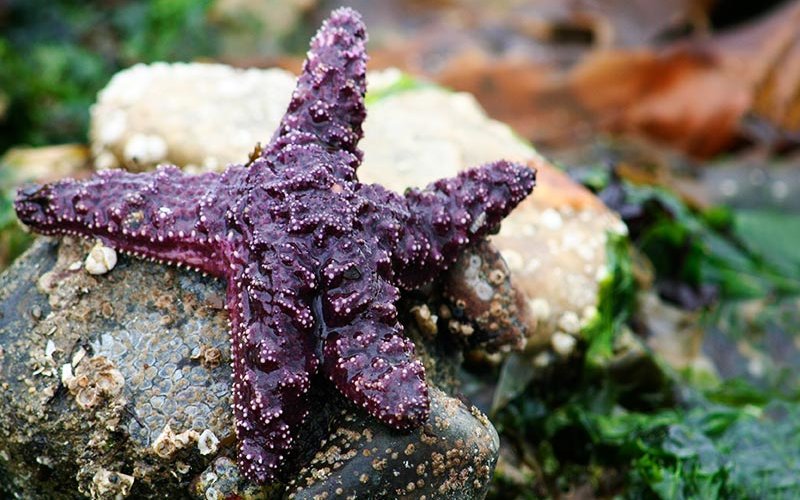
A puzzling disease is killing sea stars along the West Coast in one of the largest marine epidemics.
To understand the effects on sea star populations and what might be contributing to the onset and intensity of the outbreak, Cal State Fullerton marine biologists are collaborating on a study to learn more.
“This disease was first noted in 2013, and progresses rapidly in sea star individuals,” said Jennifer L. Burnaford, associate professor of biological science. “Sea stars can go from seemingly healthy to dead in a few days, and during the course of the sickness, the tissue seems to dissolve.”
Burnaford and Steven N. Murray, professor emeritus of biological science, are co-authors of a peer-reviewed study on the sea star outbreak published March 20 in PLOS ONE, an open-access journal.
“This large-scale research effort is unprecedented, since it is the most temporally and geographically comprehensive study of the outbreak and the effects on sea star populations to date,” noted Burnaford, who worked closely with the lead author to write the text of the paper.
“Large-Scale Impacts of Sea Star Wasting Disease on Intertidal Sea Stars and Implications for Recovery” involved a consortium of 18 research groups, known as the Multi-Agency Rocky Intertidal Network, or MARINe, which monitored and collected data from more than 130 intertidal sites along the West Coast. Murray is a founding member of MARINe, a consortium of universities, including CSUF, and federal, state and private organizations, established in the early 1990s.
The study analyzed 16 years of data — from 2000-2016 — collected by a coordinated monitoring effort at 88 sites from southern British Columbia to San Diego, including Orange County, where sea star populations are dying from the disease known as sea star wasting syndrome. Since the 1970s, similar disease outbreaks have occurred, but the epidemic over the last several years is far greater in magnitude and covers a broader geographic area, Burnaford said.
Cal State Fullerton marine scientists and scores of student researchers contributed data to the project by working with colleagues at Cal Poly Pomona to monitor four sites in Orange County: Shaws Cove and Treasure Island in Laguna Beach, Dana Point and Crystal Cove State Park. The Bureau of Ocean Energy Management has funded this work since the early 1990s.
The collective research effort revealed an unprecedented decline of sea stars in 2014 and 2015 from Alaska to San Diego, while sites in Southern California and the Channel Islands experienced more severe population declines compared to regions farther north. At the Orange County monitoring sites, researchers have not observed many juvenile sea stars, which may indicate that the outlook for population recovery will take longer in the south than in the north, Burnaford said.
Although elevated seawater temperatures and high population density have been linked to the onset and intensity of outbreaks of other marine diseases, this study did not find evidence that these factors were associated with the wasting syndrome epidemic.
“This is an important result because it highlights the fact that predicting disease epidemics is incredibly challenging, and when a disease acts as quickly as this one has, there is little time to mobilize forces to start collecting data after individuals in a population show signs of infection,” Burnaford explained.
Long-term monitoring programs like MARINe are critical, she pointed out, because they offer context to capture and understand the population impacts of such an epidemic and, ultimately, to assess disease.
“There is still much work to be done before the impacts of this disease on natural systems are fully understood,” added Burnaford. The marine biologist and her colleagues and students will continue monitoring efforts to evaluate the consequences of the epidemic on rocky intertidal shores.